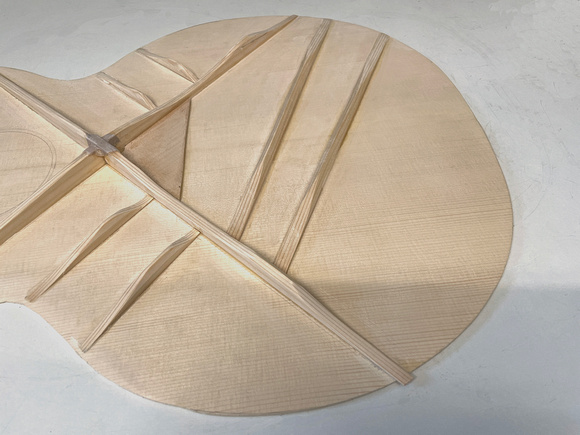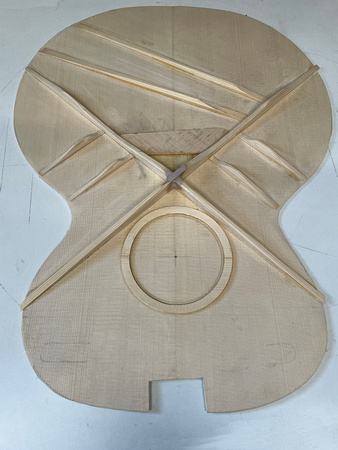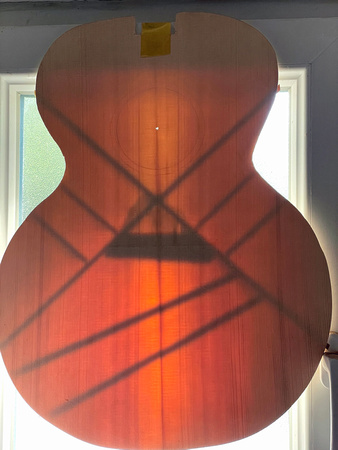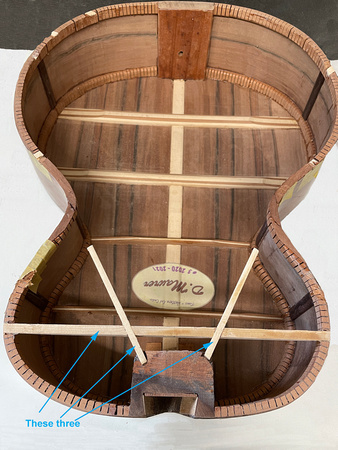
 |
|
#1
|
|||
|
|||
|
The spruce top got planed to the desired thickness with more success than I thought, I had done this myself for the first time...
The braces are glued on. How should the ends of them run out? With thin recesses in the kerfed linings up to the edge or without any contact to them at all? Here's a photo  Btw, the spruce looks dirtier than it really is... 
__________________
Thanks!  Martin D28 (1973) 12-string cutaway ...finished ;-) Hoyer 12-string (1965) Yamaha FG-340 (1970) Yamaha FG-512 (ca. 1980) D.Maurer 8-string baritone (2013-2014) and 4 electric axes |
|
#2
|
|||
|
|||
|
Ends of the X-braces and the upper transverse brace should be inletted into the kerfing. The transverse brace and upper ends of the X braces should be 1/8" to 3/16" tall at the kerfing. The lower ends of the X braces can be shorter. I usually make those about the same as the top thickness.
The other braces are shaved down nearly to the top surface such that no notches in the kerfing are required. This inletting is done because the downward pressure from string tension above the bridge can cause the brace ends to pop loose, and cause top sinkage. For that reason, it is very important that the fit be close between the brace and the kerfing notch. Some builders shave down the lower ends of the X braces, since the string tension is pulling up on the top in that area. But I like to account for incidental forces on the top. Also, the shorter the braces are on the ends, the looser the top becomes. The added bass response may not be welcome. |
|
#3
|
|||
|
|||
|
Quote:
I don't build many guitars because there are so many great factory instruments available. I built the guitar I currently play because there were details that weren't available in a commercially produced instrument, plus the total cost was only a few hundred dollars. My guitar (slightly bigger than a size 0 and also a bit deeper) uses over-square bracing, wider than the brace height. The X brace and the upper transverse brace are notched into the linings (left 1/8" at the linings) and all other braces stop short of the linings and taper down to about 1/16". I've been playing it exclusively for the last couple of years and I LOVE the tone and projection. That's my take on design. (...unless I build another...)  A final thought... the sound hole is a whole lot easier to cut out BEFORE adding braces! |
|
#4
|
|||
|
|||
|
Thank you for your friendly hints!
Btw, I didn´t cut the soundhole before adding the braces because I want to add an abalone ring around the soundhole but could not yet rout before measuring exactly the needed material that´s on its way to me... Besides that I'm going to remove the triangular maple reinforcement under the bridge and glue a smaller stripe further back.
__________________
Thanks!  Martin D28 (1973) 12-string cutaway ...finished ;-) Hoyer 12-string (1965) Yamaha FG-340 (1970) Yamaha FG-512 (ca. 1980) D.Maurer 8-string baritone (2013-2014) and 4 electric axes Last edited by viento; 09-28-2022 at 04:13 PM. |
|
#5
|
|||
|
|||
|
Your bridge plate doesn’t look oversized to me. What specifically are you wanting to improve? I’m assuming you radiused the top. How are you going to cut the sound hole? No criticism, just curious.
__________________
BradHall _____________________ |
|
#6
|
|||
|
|||
|
The bridge plate sits completely in the X of the braces and makes that area very stable. If it slides a little further down, the sound might be a little fuller, but I don't know for sure. I will try it...
__________________
Thanks!  Martin D28 (1973) 12-string cutaway ...finished ;-) Hoyer 12-string (1965) Yamaha FG-340 (1970) Yamaha FG-512 (ca. 1980) D.Maurer 8-string baritone (2013-2014) and 4 electric axes |
|
#7
|
|||
|
|||
|
Too much "stability" kills the top's need to respond to string energy. It also appears that the bridge plate isn't located far enough toward the tail block to support the ball ends, unless you're doing a pinless bridge design. Even in the case of using a pinless bridge the bridge plate functions to couple energy to the top plate, as well as adding stability at the rear edge of the bridge location to prevent bridge lift.
|
|
#8
|
|||
|
|||
|
Quote:
|
|
#9
|
|||
|
|||
|
Sometimes it's just better to wait, I suspect you will have a difficult time cutting that sound hole out
 As John mentioned the upper portion of the braces above the sound hole absolutely must be fitted to the linings and fitted very well at that. What I do with the lower braces is feather them till they are paper thin and then glue the sides and linings right over them. My 'theory' is that it will prevent the brace end from pealing up as that is what they are want to do over time. For the lower face braces you definitely want to feather to zero and not leave a thick end. A thick end will make it much easier for the brace to peal away from the soundboard. Same with the outer edges of the finger braces. |
|
#10
|
|||
|
|||
|
Quote:
|
|
#11
|
|||
|
|||
|
Quote:
|
|
#12
|
|||
|
|||
|
Thanks for your advices!
Final conclusion: If all of that work does not bring a good result and the top does not sound like I hope it will, I´ll remove it from the kerfed linings and optimistically make a new one...  I hung the top in front of the window so that the braces and especially the bridge plate can be seen. Around the soundhole I glue a small reinforcing ring that sits under the abalone inlays.The center of the soundhole is the white spot and I guess that it will fit well.  The scale is 65cm / 25,5906" and the bridge plate covers that well.   Btw,By the way, I glued three bars to the upper part of the guitar for reinforcement.  I routed and glued the abalone in. I only have to sand it flash and cut the soundhole what will not be difficult...I guess. I´ll cut it with my Dremel with a cut down bit. Pic viewed from the fb side. 
__________________
Thanks!  Martin D28 (1973) 12-string cutaway ...finished ;-) Hoyer 12-string (1965) Yamaha FG-340 (1970) Yamaha FG-512 (ca. 1980) D.Maurer 8-string baritone (2013-2014) and 4 electric axes Last edited by viento; 09-30-2022 at 09:24 AM. |
|
#13
|
|||
|
|||
|
That is what is called an A-Brace and I do the same thing though not exactly the way you are handling it here. This is a very different style of building and I am wondering are you making this up as you go along or are you following some sort of guide?
It's very unusual to cut the soundhole as the last thing and to install braces on the body like that before gluing down the top. Why would you not glue the A-Brace to the top first? I am not saying what you ae doing is wrong but I am curios as to what your thinking is. |
|
#14
|
|||
|
|||
|
I apologize, I didn't mention that the guitar was already built. I had used a red cedar top with a pinless bridge but wasn't happy with the sound. I wasn't paying attention and misread the plan. The two lower braces had been glued wrong way around. That's probably where the lack of bass came from. So when I took a closer look at the plan, I noticed my stupid mistake. So I took off the red cedar top and now use a spruce top with a pin-through bridge. The bridge will be "normal". Maybe then the sound will be better overall.
The braces that are already glued in are from the first top and I think to use them again. All in all a bit of work but apart from building guitars and playing golf I don't have much to do as a pensioner...  ...joke! ...joke!
__________________
Thanks!  Martin D28 (1973) 12-string cutaway ...finished ;-) Hoyer 12-string (1965) Yamaha FG-340 (1970) Yamaha FG-512 (ca. 1980) D.Maurer 8-string baritone (2013-2014) and 4 electric axes |
|
#15
|
|||
|
|||
|
Reversing the tone bars by itself is not the reason for lack of bass. I would concentrate on the overall stiffness of the top. Pay close attention to the height of the braces, especially the minimum height of the scoops on the X braces. Small changes there can have a big effect on bass response.
Thicker tops also tend to result in less bass. |